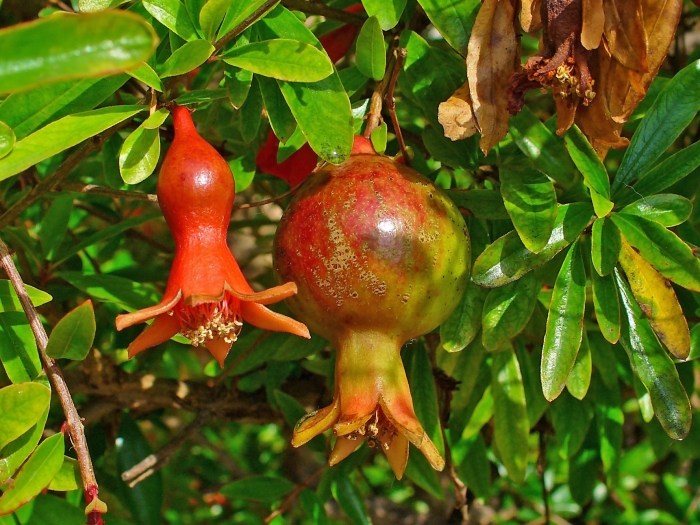Pomegranate
(Punica granatum)
Pomegranate (Punica granatum)
/
/

H. Zell
CC BY-SA 3.0


































































































Estimated Native Range
Summary
Pomegranates are valued for their ornamental beauty, delicious fruit, and medicinal properties. They are commonly used in culinary applications and are also planted as specimen trees or for hedges in gardens. They are drought-tolerant, making them suitable for xeriscaping, and can grow in a variety of soil types, though they prefer well-drained soil. Full sun is ideal for fruit production, but they can also tolerate part shade. While they can withstand moderate frost, they are susceptible to root rot in overly wet conditions and may suffer from pests like the pomegranate butterfly and fruit flies.CC BY-SA 4.0
Plant Description
- Plant Type: Tree, Shrub
- Height: 6-20 feet
- Width: 4-15 feet
- Growth Rate: Slow
- Flower Color: Red
- Flowering Season: Spring, Summer
- Leaf Retention: Deciduous, Evergreen
Growth Requirements
- Sun: Full Sun
- Water: Medium
- Drainage: Medium, Slow
Common Uses
Bank Stabilization, Bee Garden, Bird Garden, Border Plant, Butterfly Garden, Deer Resistant, Drought Tolerant, Edible*Disclaimer: Easyscape's listed plant edibility is for informational use. Always verify the safety and proper identification of any plant before consumption., Erosion Control, Fire Resistant, Hedges, Hummingbird Garden, Potted Plant, Salt Tolerant, Showy Flowers, Street Planting
Natural Habitat
Regions from Iran to the Himalayas in northern India and cultivated throughout the Mediterranean region
Other Names
Common Names: Granatäpple, 石榴, Granada, Granatapfel, Granado, Grenadier, Shi Liu, Zakuro
Scientific Names: , Punica granatum, Punica multiflora, Punica nana, Punica granatum var. granatum, Granatum puniceum, Granatum punicum, Punica florida, Punica granatum var. sativum, Punica grandiflora
GBIF Accepted Name: Punica granatum L.